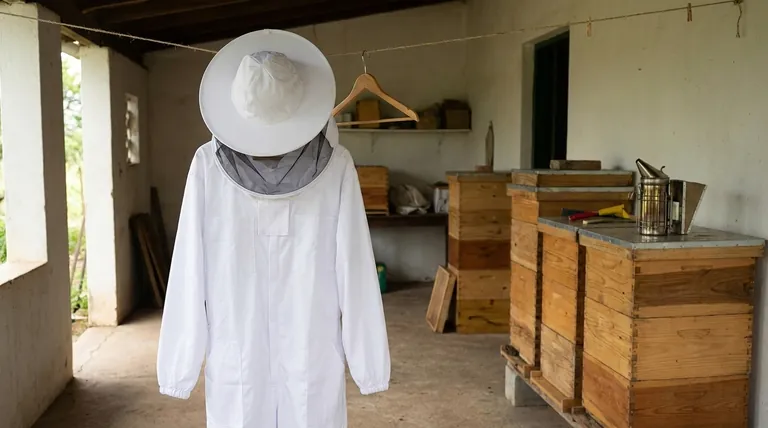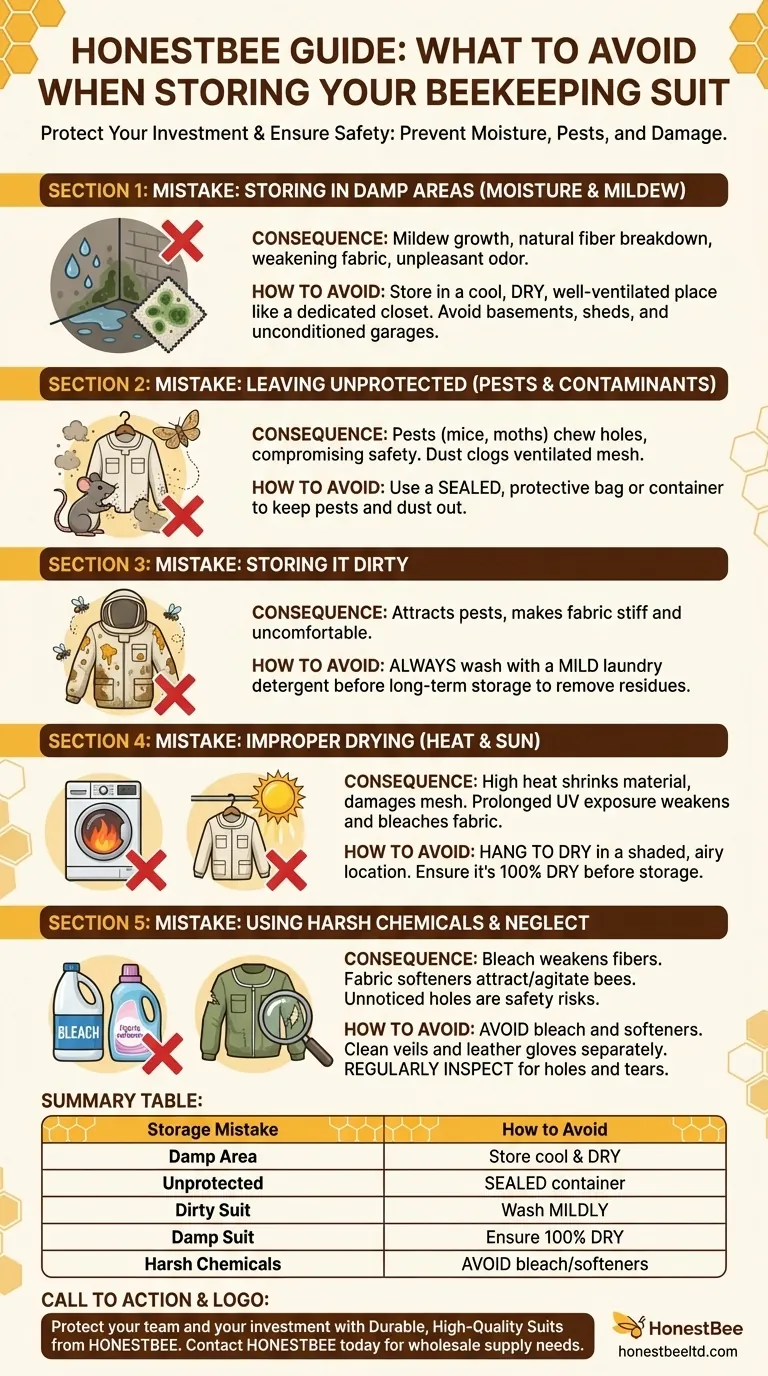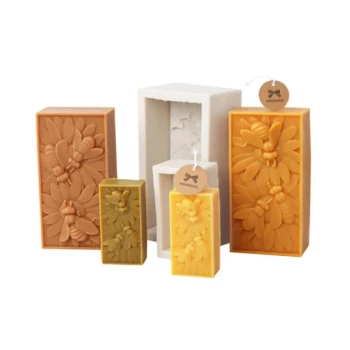To properly store a beekeeping suit, you must primarily avoid two things: moisture and pests. Storing a suit in a damp location like a basement or garage can lead to mildew and fabric degradation, while leaving it unprotected can invite pests that may damage the material, compromising its safety and shortening its lifespan.
The core principle of beekeeping suit care is that storage is the final step in a larger process. A suit that is properly cleaned, thoroughly dried, and carefully inspected before being put away will remain protective and last for many seasons.

The Primary Threats to Your Suit's Integrity
A beekeeping suit is a critical piece of safety equipment. Understanding what damages it is the first step toward proper maintenance and storage.
Moisture and Mildew
The single greatest threat during storage is moisture. Damp environments cause natural fibers like cotton to break down and can lead to mildew growth.
This not only creates a foul odor but structurally weakens the fabric, making it more susceptible to rips and tears. Areas like basements, sheds, and some garages are often unsuitable for this reason.
Pests and Contaminants
Mice, moths, and other pests can chew through suit material, creating holes that render it useless for protection.
Beyond pests, simply leaving a suit exposed allows dust and debris to accumulate, which can clog the mesh of ventilated suits and reduce their effectiveness.
The Link Between Washing, Drying, and Storing
Proper storage is impossible without first addressing cleaning and drying. Storing a dirty or even slightly damp suit is a recipe for failure.
The Mistake of Storing It Dirty
Never store a suit for an extended period without washing it. Remnants of propolis, wax, and alarm pheromone can attract pests and make the fabric stiff.
Use a mild laundry detergent for washing. Aggressive chemicals can degrade the protective qualities of the fabric.
The Dangers of Improper Drying
Never use a machine dryer for your beekeeping suit. The high heat can shrink the material and damage the delicate mesh of the veil and any ventilated panels.
Likewise, avoid drying it in direct sunlight. Prolonged UV exposure will weaken and bleach the fabric, reducing its strength and protective capabilities over time.
The Correct Drying Process
The only safe method is to hang the suit to dry in a well-ventilated area that is out of direct sunlight, such as a shaded porch or airy room.
Crucially, you must ensure the suit is 100% dry before storage. Even a small amount of lingering moisture in thicker seams can lead to mildew.
Common Pitfalls to Avoid
Proper care extends beyond just washing and storage. Certain mistakes can compromise your suit's effectiveness and your safety.
Using Harsh Chemicals
Avoid bleach and fabric softeners at all costs. Bleach will severely weaken the fabric's fibers, while fabric softeners can leave a residue that may attract and agitate bees.
Mishandling Veils and Gloves
Your veil and gloves require special attention. Never machine wash or dry the veil or any leather gloves. Submerging the veil can warp its shape, and machine washing will ruin leather. Clean these items separately according to their specific instructions.
Neglecting Regular Inspections
Before every use and especially before long-term storage, inspect the entire suit for holes or tears. A small hole is a significant safety risk. Storing a damaged suit means it won't be ready or safe for your next hive inspection.
Making the Right Choice for Your Goal
Your storage routine may vary slightly depending on how you use your equipment.
- If your primary focus is frequent, routine use: Air the suit out thoroughly after each use in a shaded, ventilated area to ensure it's dry before you need it again.
- If your primary focus is long-term, off-season storage: Perform a full wash with mild detergent, hang it until completely dry, and then place it in a sealed, protective bag in a cool, dry closet.
- If your primary focus is maximum safety: Make a habit of inspecting all seams, zippers, and elastic bands for wear and tear before you put the suit on for every single inspection.
Properly caring for your suit is a direct investment in your own safety and the longevity of your equipment.
Summary Table:
| Storage Mistake | Consequence | How to Avoid |
|---|---|---|
| Storing in a damp area | Mildew growth, fabric degradation | Store in a cool, dry place like a closet |
| Leaving suit unprotected | Damage from pests (mice, moths) | Use a sealed, protective bag or container |
| Storing a dirty suit | Attracts pests, stiffens fabric | Always wash with mild detergent before storage |
| Storing a damp suit | Mildew, even from slight moisture | Ensure suit is 100% dry before storing |
| Using harsh chemicals | Weakens fabric, agitates bees | Avoid bleach and fabric softeners |
Protect your beekeepers and your investment with durable, high-quality suits from HONESTBEE.
Proper storage is the final step, but it starts with reliable equipment. HONESTBEE supplies commercial apiaries and beekeeping equipment distributors with wholesale-focused beekeeping supplies and equipment built to last. Ensure your team's safety and maximize the lifespan of your gear.
Contact HONESTBEE today to discuss your wholesale supply needs and equip your operation with the best.
Visual Guide

Related Products
- Cotton Beekeeping Suit and Round Hat with Veil Bee Keeper Protective Gear
- White Beekeeping Protective Suit and Hat with Fencing Veil for Beekeepers
- Professional Beekeeping Suit for Kids and Girls Childrens Bee Keeper Suit
- Heavy Duty Cowboy Beekeeper Hat with Visibility Veil Outdoor Professional Beekeeping Protective Gear
- Beekeeper Cowboy Hat and Veil for Beekeeping
People Also Ask
- Why is a jacket with a hat veil recommended for beekeepers? Essential Protection for Your Face and Neck
- What are bee suits made of? Choosing the Right Material for Maximum Protection & Comfort
- How should a beekeeping suit be hung to maintain its shape? Protect Your Investment with Proper Storage
- Why is white the predominant color in bee suit designs? | Key to Hive Calm & Beekeeper Safety
- How should a bee suit be cleaned? Protect Your Investment and Ensure Apiary Safety



















